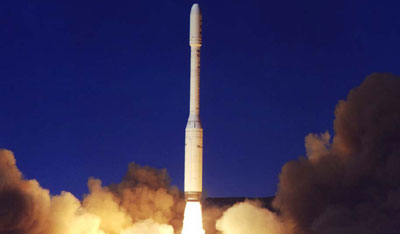Operationally Responsive Spacelift: A solution seeking a problem?<< page 1: different approaches Who needs it?There’s no question that operationally responsive spacelift has generated a buzz in the launch industry, either out of genuine interest in the concept itself or because of the possibility of lucrative government contracts to develop such a vehicle. What remains unclear, though, is exactly what payloads require both low cost and responsive launch vehicles. Lou Amorosi, vice president of Orbital Sciences Corporation, noted during the Space 2003 panel session that operationally responsive spacelift is not really a new concept. Orbital designed the Pegasus launch vehicle to carry out one to two launches a month, he said, with a surge rate of one a week. The Taurus, meanwhile, was designed to launch on a flat pad on just eight days’ notice. While Pegasus and Taurus were designed for relatively high launch rates and launches on short notice, in practice these attributes have not been utilized. The Pegasus has flown only 35 times since its introduction in 1990, an average of less than three launches a year. The Taurus, introduced in 1994, has launched only six times (a seventh is scheduled for next month.)
If operationally responsive spacelift is so important, why aren’t existing vehicles capable of launching on short notice in greater demand? The Space 2003 panelists offered a variety of answers. Amorosi suggested that a lack of payloads has been a big part of the problem. Conger, on the other hand, said that the high cost of existing vehicles—a Pegasus launch is estimated to cost $20-25 million—is keeping these vehicles from being used. He suggested that if the total cost of a mission, including the launch vehicle, spacecraft, and all operations, could be reduced to below $20 million, such a system could become “a real driver” for launch demand. However, what payloads would require launch on such short notice is something that remains to be determined. Air Force officials have talked about launching reconnaissance satellites on short notice to keep an eye on hot spots as they develop around the world. However, to date the Defense Department has focused on much larger reconnaissance satellites, too big to fit on a FALCON SLV. While the Air Force has experimented with a number of small spacecraft, primarily to develop new technologies, whether the military develops any small reconnaissance or other satellites that can be built and stored for launch on short notice is today uncertain.
Another uncertainty is if a vehicle can both be operationally responsive and still be low cost. Amorosi pointed that that launching on even two days’ notice may require a dedicated vehicle and launch site for a ground-launched vehicle, or a dedicated aircraft and vehicle for air-launched systems. The expense required to maintain these assets, particularly if they are used fairly infrequently, could wipe out any low-cost attributes of the vehicle itself. While the responsiveness needs of the FALCON SLV are uncertain, there is near unanimity that there is strong demand for a small low-cost launcher. Many university-built satellites are sitting on the ground because of a lack of affordable launch opportunities, and there is plenty of anecdotal evidence from industry and the government that high launch costs have hindered the utilization of small satellites. Air Force Colonel Rich White, director of the Space Test Program, said that there is a need to reduce space access costs. “The STP budget is fixed, so we need launch vehicle costs to go down,” he said. Right now vehicle developers are optimistic that they can provide boosters that can meet both the cost and responsiveness requirements of FALCON. However, history is littered with vehicle projects that have failed to meet their performance expectations. Should the time come when the Pentagon and/or a vehicle developer is facing a tradeoff between low cost and responsiveness, they should think long and hard about what the needs for responsive launch really are before altering a vehicle that could offer affordable access to space for small payloads. Home |
|
